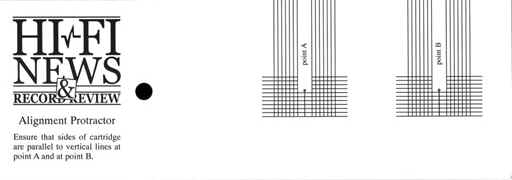-edible zone-
Above: Top view showing the two points of alignment.
The object of the two point protractor is to achieve best
possible alignment at 'both' null points. When correctly set, the stylus
will have a near perfect groove tangency at two specified points on the
record, minimizing tracking error between and beyond the null points.
The above image shows the two null points in relation to each other.
With the platter immobilized, the protractor will be rotated to check
adjustment at each null point. For an explanation of the adjustment
procedure, see the illustration and text below.

Above pic: --not to scale-- This two point protractor comes with the HFNRR test record. It is based upon the Baerwald* calculations using nulls at 66 and 120.89 mm from spindle center. *also known as Lofgren A

Above image shows adjustments to be made. Can you see the slight mis-alignment
to the zenith adjustment...? 'gotta fix that. 8^)
Making
the Adjustments
Overhang adjustment:
To adjust overhang,
we must adjust the mounting length between the stylus and tonearm pivot.
Typically, the head shell will offer --fore and aft-- adjustment by way
of mounting screw slots, as in a Rega tonearm, or perhaps a
'sled-in-a-slide-way', as used in the Thorens TP60 headshell. To adjust
mounting length, loosen the fasteners 'just enough' to allow the
cartridge to be slid in either direction within the headshell until the
stylus is centered over the null point.
(Note: To adjust an SME
tonearm for overhang, refer to the SME owners manual. The method is
different.)
Zenith angle adjustment:
To adjust Zenith
angle, the cartridge body is rotated within the head shell until a
parallel alignment exists between the cantilever and the grid lines on
the protractor. As with the overhang adjustment, leave the fasteners
just slack enough to make the rotation, but snug enough to hold the new
position.
If the protractor is a mirrored surface, it will be
possible to visually evaluate the parallel alignment between the
cantilever and the grid. However, if the protractor is paper, you may
have to settle for aligning the cartridge body sides parallel to the
grid since it will not be possible to get a visual fix between the grid
and the cantilever. Use good lighting and magnifiers.
Finishing:
Snug up the mounting screws firmly then double check your alignment
using the protractor.... and that is our overhang adjustment using a two
point protractor. Piece of cake.
Notes:
1) The object
of the two point protractor is to achieve best possible alignment
described above at 'both' null points.
2) If it becomes apparent
that the stylus will not align over both null points by the above
method, I can think of two possible causes.
The first cause might be inadequate room in the slots. In effect the
cartridge can't be moved forward enough to reach the null point.
Typically this happens when using a Baerwald based protractor. Baerwald
alignments result in longer overhang values. I prefer to use the
Baerwald alignment whenever I can for its slightly lower tracking error
values, however if it becomes necessary, a different protractor (perhaps
Lofgren or Stevenson) may be needed with some combinations of tone arms
and cartridges.
The second cause might be an incorrect
pivot-to-spindle mounting distance. Typically this can happen when
pivot-to-spindle distances are made adjustable at the arm board, or if a
different tonearm has been incorrectly installed to the turntable. I
recommend that this very important mounting distance, pivot-to-spindle,
is checked and compared to the tone arm manufactures specification. A
special gage is required. For one example of a gage that measures 'pivot
to spindle', link here. Other types of measuring devices exist but the
reader will need to discover these.
3) This page is designed to
be a simple operational guide to the use of a 2-point protractor. It's
not the purpose here to study or attempt to explain the difference
between different alignment theories. I'm just a happy idiot that want's
to play records. If the reader would like to wade deep into the
calculus of tone arm alignment theory, this link is to a page that
contains the formal papers by
Baerwald, Bauer, Lofgren and Stevenson.
http://www.helices.org/auDio/turnTable/